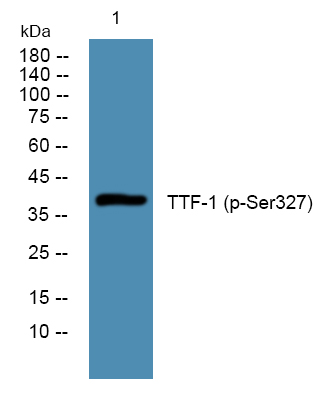TTF-1 (Phospho Ser327) rabbit pAb
- Catalog No.:YP1537
- Applications:WB
- Reactivity:Human;Rat;Mouse;
- Target:
- TTF-1
- Gene Name:
- NKX2-1 NKX2A TITF1 TTF1
- Protein Name:
- TTF-1 (Ser327)
- Human Gene Id:
- 7080
- Human Swiss Prot No:
- P43699
- Mouse Gene Id:
- 21869
- Mouse Swiss Prot No:
- P50220
- Rat Swiss Prot No:
- P23441
- Immunogen:
- Synthesized phosho peptide around human TTF-1 (Ser327)
- Specificity:
- This antibody detects endogenous levels of Human TTF-1 (phospho-Ser327)
- Formulation:
- Liquid in PBS containing 50% glycerol, 0.5% BSA and 0.02% sodium azide.
- Source:
- Polyclonal, Rabbit,IgG
- Dilution:
- WB 1:1000-2000
- Purification:
- The antibody was affinity-purified from rabbit serum by affinity-chromatography using specific immunogen.
- Concentration:
- 1 mg/ml
- Storage Stability:
- -15°C to -25°C/1 year(Do not lower than -25°C)
- Other Name:
- Homeobox protein Nkx-2.1 (Homeobox protein NK-2 homolog A) (Thyroid nuclear factor 1) (Thyroid transcription factor 1) (TTF-1)
- Observed Band(KD):
- 38kD
- Background:
- This gene encodes a protein initially identified as a thyroid-specific transcription factor. The encoded protein binds to the thyroglobulin promoter and regulates the expression of thyroid-specific genes but has also been shown to regulate the expression of genes involved in morphogenesis. Mutations and deletions in this gene are associated with benign hereditary chorea, choreoathetosis, congenital hypothyroidism, and neonatal respiratory distress, and may be associated with thyroid cancer. Multiple transcript variants encoding different isoforms have been found for this gene. This gene shares the symbol/alias 'TTF1' with another gene, transcription termination factor 1, which plays a role in ribosomal gene transcription. [provided by RefSeq, Feb 2014],
- Function:
- disease:Defects in NKX2-1 are the cause of benign hereditary chorea (BHC) [MIM:118700]; also known as hereditary chorea without dementia. BHC is an autosomal dominant movement disorder. The early onset of symptoms (usully before the age of 5) and the observation that in some BHC families the symptoms tend to decrease in adulthood suggests that the disorder results from a developmental disturbance of the brain. BHC is non-progressive and patients have normal or slightly below normal intelligence. There is considerable inter- and intrafamilial variability, including dysarthria, axial distonia and gait disturbances.,disease:Defects in NKX2-1 are the cause of choreoathetosis, hypothyroidism, and neonatal respiratory distress (CHNRD) [MIM:610978]. This syndrome include neurological, thyroid, and respiratory problems.,function:Transcription factor that binds and activates the promoter of thyro
- Subcellular Location:
- Nucleus .
- Expression:
- Thyroid and lung.
- June 19-2018
- WESTERN IMMUNOBLOTTING PROTOCOL
- June 19-2018
- IMMUNOHISTOCHEMISTRY-PARAFFIN PROTOCOL
- June 19-2018
- IMMUNOFLUORESCENCE PROTOCOL
- September 08-2020
- FLOW-CYTOMEYRT-PROTOCOL
- May 20-2022
- Cell-Based ELISA│解您多样本WB检测之困扰
- July 13-2018
- CELL-BASED-ELISA-PROTOCOL-FOR-ACETYL-PROTEIN
- July 13-2018
- CELL-BASED-ELISA-PROTOCOL-FOR-PHOSPHO-PROTEIN
- July 13-2018
- Antibody-FAQs
- Products Images

- Western blot analysis of lysates from HCT116 cells, primary antibody was diluted at 1:1000, 4°over night



